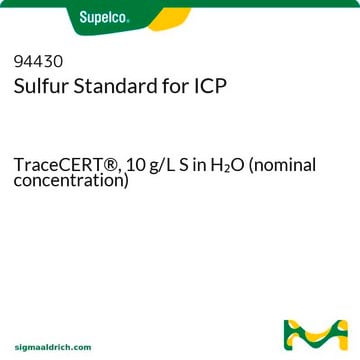1.00318
Hydrochloric acid
30%, SUPRAPUR®
Synonym(s):
Hydrochloric acid solution, Hydrochloric acid 30%, Hydrogen chloride solution
About This Item
Recommended Products
product name
Hydrochloric acid solution, 30% Suprapur®
grade
for inorganic trace analysis
Quality Level
Agency
suitable for EPA 200.7
suitable for EPA 200.8
vapor pressure
21.8 hPa ( 20 °C)
Assay
30%
form
liquid
pH
<1 (20 °C, 300 g/L in H2O)
bp
85 °C/1013 hPa
mp
-50 °C
density
1.15 g/cm3 at 20 °C
storage temp.
15-25°C
SMILES string
Cl
InChI
1S/ClH/h1H
InChI key
VEXZGXHMUGYJMC-UHFFFAOYSA-N
Looking for similar products? Visit Product Comparison Guide
Related Categories
Application
- Optimization of enantioselective high-performance liquid chromatography-tandem mass spectrometry method for the quantitative determination of 3,4-methylenedioxy-methamphetamine (MDMA) and its phase-1 metabolites in human biological fluids.: This study highlights the use of hydrochloric acid solution in the sample preparation process for precise analytical determination of MDMA and its metabolites using HPLC-MS/MS (Sprega et al., 2024).
- Coprecipitation as a One-Step Se Separation for Determination of Isotope Ratios Completed with Revised Uncertainty Evaluation.: This research employs hydrochloric acid solution in the coprecipitation method for selenium isotope separation, enhancing analytical accuracy and reliability (Karasiński et al., 2024).
- Removal of Methyl Red from Aqueous Solution Using Biochar Derived from Fennel Seeds.: This paper explores the use of hydrochloric acid solution in the preparation of biochar for effective removal of methyl red dye from water, contributing to environmental cleanup efforts (Paluch et al., 2023).
- Tyrosine Amino Acid as a Foulant for the Heterogeneous Anion Exchange Membrane.: The research investigates the use of hydrochloric acid solution in the study of tyrosine amino acid fouling on anion exchange membranes, providing insights into membrane fouling mechanisms (Kharina and Eliseeva, 2023).
Analysis Note
Colour: ≤ 10 Hazen
Bromide (Br): ≤ 10 ppm
Free chlorine (Cl): ≤ 300 ppb
Phosphate (PO₄): ≤ 10 ppb
Sulphate (SO₄): ≤ 300 ppb
Sulfite (SO₃): ≤ 500 ppb
Ag (Silver): ≤ 1.0 ppb
Al (Aluminium): ≤ 1.0 ppb
As (Arsenic): ≤ 1.0 ppb
Au (Gold): ≤ 1.0 ppb
Ba (Barium): ≤ 1.0 ppb
Be (Beryllium): ≤ 1.0 ppb
Bi (Bismuth): ≤ 1.0 ppb
Ca (Calcium): ≤ 5.0 ppb
Cd (Cadmium): ≤ 0.5 ppb
Co (Cobalt): ≤ 1.0 ppb
Cr (Chromium): ≤ 1.0 ppb
Cu (Copper): ≤ 1.0 ppb
Fe (Iron): ≤ 5.0 ppb
Ga (Gallium): ≤ 0.5 ppb
Ge (Germanium): ≤ 10.0 ppb
Hg (Mercury): ≤ 2.0 ppb
In (Indium): ≤ 0.5 ppb
K (Potassium): ≤ 10.0 ppb
Li (Lithium): ≤ 0.5 ppb
Mg (Magnesium): ≤ 2.0 ppb
Mn (Manganese): ≤ 0.5 ppb
Mo (Molybdenum): ≤ 0.5 ppb
NH₄ (Ammonium): ≤ 500 ppb
Na (Sodium): ≤ 10.0 ppb
Ni (Nickel): ≤ 1.0 ppb
Pb (Lead): ≤ 0.5 ppb
Pt (Platinum): ≤ 0.5 ppb
Sb (Antimony): ≤ 0.5 ppb
Sn (Tin): ≤ 1.0 ppb
Sr (Strontium): ≤ 0.5 ppb
Ti (Titanium): ≤ 1.0 ppb
Tl (Thallium): ≤ 0.5 ppb
V (Vanadium): ≤ 1.0 ppb
Zn (Zinc): ≤ 1.0 ppb
Zr (Zirconium): ≤ 0.5 ppb
Residue on ignition (as sulphate): ≤ 2 ppm
Actual analysis values are subject to unavoidable systematic variations in this concentration range
The actual values are subject to unavoidable systematic
variations in this concentration range.
Legal Information
Signal Word
Danger
Hazard Statements
Precautionary Statements
Hazard Classifications
Eye Dam. 1 - Met. Corr. 1 - Skin Corr. 1B - STOT SE 3
Target Organs
Respiratory system
Storage Class Code
8B - Non-combustible, corrosive hazardous materials
WGK
WGK 1
Flash Point(F)
Not applicable
Flash Point(C)
Not applicable
Certificates of Analysis (COA)
Search for Certificates of Analysis (COA) by entering the products Lot/Batch Number. Lot and Batch Numbers can be found on a product’s label following the words ‘Lot’ or ‘Batch’.
Already Own This Product?
Find documentation for the products that you have recently purchased in the Document Library.
Customers Also Viewed
Articles
Control elemental impurities in drug products with analytical methods and materials to ensure patient safety.
Control elemental impurities in drug products with analytical methods and materials to ensure patient safety.
Control elemental impurities in drug products with analytical methods and materials to ensure patient safety.
Control elemental impurities in drug products with analytical methods and materials to ensure patient safety.
Related Content
Atomic spectroscopy techniques like AAS, AES, ICP-OES, and ICP-MS identify and quantify elemental composition in samples.
Atomic spectroscopy techniques like AAS, AES, ICP-OES, and ICP-MS identify and quantify elemental composition in samples.
Atomic spectroscopy techniques like AAS, AES, ICP-OES, and ICP-MS identify and quantify elemental composition in samples.
Atomic spectroscopy techniques like AAS, AES, ICP-OES, and ICP-MS identify and quantify elemental composition in samples.
Our team of scientists has experience in all areas of research including Life Science, Material Science, Chemical Synthesis, Chromatography, Analytical and many others.
Contact Technical Service




